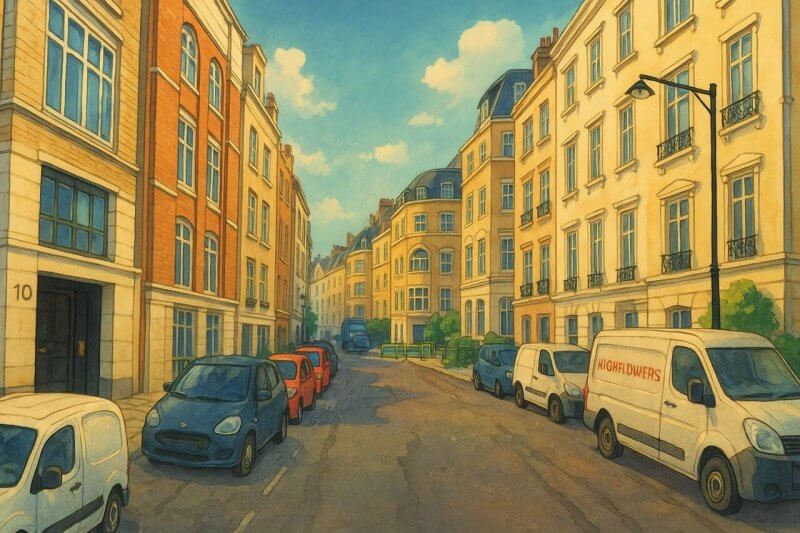
Grosvenor Street, Westminster: Riverside Grandeur in Central London
Where is Grosvenor Street?
Grosvenor Street is located in the prestigious district of Mayfair, within the City of Westminster, central London. It runs east to west, connecting the bustling commercial district around Bond Street with the leafy residential enclave near Grosvenor Square.Length and Orientation
Grosvenor Street stretches for approximately 0.4 miles (around 650 metres). It begins at New Bond Street in the east and runs westward to Grosvenor Square, a historic and elegant garden square known for its diplomatic buildings and heritage.History of Grosvenor Street
Grosvenor Street dates back to the early 18th century, having been laid out around the 1720s during the development of Mayfair by the powerful Grosvenor family. It was designed as a key thoroughfare within the estate and formed part of the larger vision to transform the formerly rural Mayfair area into a fashionable residential quarter for London's elite.The street's character has changed over the centuries - from grand private residences in the Georgian and Victorian eras to today's blend of commercial and institutional uses.
Origin of the Name
As with many locations in Mayfair, Grosvenor Street is named after the Grosvenor family, notably the Dukes of Westminster. The Grosvenors were major landowners who developed large swathes of central London including Belgravia and Mayfair. Their legacy remains visible throughout the area in street names, architecture, and the ongoing management by the Grosvenor Estate.How to Pronounce "Grosvenor"
The name "Grosvenor" might look like it should be pronounced with all its letters, but it's actually a bit deceptive. In standard British English, it's pronounced "GROV-ner", where the middle "s" and the second "o" are silent. This refined pronunciation reflects the name's aristocratic roots - a fitting match for such an elegant and historic street in the heart of Mayfair. Mispronunciations like "Gross-ven-or" or "Groze-ven-or" are common among visitors, but locals and Londoners-in-the-know stick with the more polished "GROV-ner."Connecting Roads
Grosvenor Street links with several prominent streets in Mayfair:- Davies Street - intersects Grosvenor Street midway, with shops and office buildings
- Brook Street and Upper Brook Street - run parallel to Grosvenor Street, forming part of Mayfair's elegant grid
- Carlos Place
- Grosvenor Square - anchors the western end of the street with historic townhouses and embassies
- Maddox Street - stylish Mayfair thoroughfair
- New Bond Street - a major shopping destination lined with luxury boutiques and galleries
- Upper Grosvenor Street - western section that connects to Park Lane.
The Character of Grosvenor Street
Grosvenor Street today is a prestigious commercial and institutional street with a mix of historic architecture and modern corporate headquarters. It is home to:- Wealth management firms and private banks
- Discreet law offices and embassies
- Luxury serviced offices housed in Georgian townhouses
Landmarks and Sights on Grosvenor Street
Although relatively short, Grosvenor Street boasts a number of notable features:- The Royal Academy of Dramatic Art (RADA) Business - offering corporate training in performance and communication skills
- Grade II-listed buildings - many of the street's Georgian façades are protected for their architectural and historical value
- Proximity to Grosvenor Square - once home to the U.S. Embassy and now a beautifully landscaped public space
Nearest London Underground Stations
Grosvenor Street is easily accessible by Tube:- Bond Street Station - located at the eastern end, served by the Central and Jubilee lines
- Oxford Circus Station - a short walk to the northeast, on the Bakerloo, Central, and Victoria lines
- Green Park Station - within 10 minutes' walk, served by the Piccadilly, Victoria, and Jubilee lines
Fun Fact: Grosvenor Street's Discreet Wealth
Although it doesn't boast flashy retail like nearby Bond Street, Grosvenor Street is one of the most expensive office locations in Europe. Many of its seemingly quiet doorways lead to private equity firms, hedge funds, and luxury service providers. The discreet, understated elegance is a hallmark of old-money Mayfair - wealth here speaks in whispers, not shouts.Conclusion
Grosvenor Street is an iconic part of Mayfair's storied landscape - a place where Georgian grandeur meets modern power and prestige. With a rich heritage, a central location, and timeless architecture, it continues to play a vital role in the life of one of London's most distinguished districts. Whether you're passing through or working behind one of its historic façades, Grosvenor Street is a symbol of refinement and resilience in the heart of the city.Who Were the Grosvenors, and How Did They Acquire This Land?
If you're wondering why so many streets and squares in this area bear names like Grosvenor, Belgrave, Eaton, or Wilton, it's because much of this land once belonged to the powerful Grosvenor family. To find out how they came to own vast swathes of Mayfair, Belgravia, and Pimlico — and whether they had any ties to the government or the royal family — read our in-depth article here.
Map of Grosvenor Street, London

Painting of Grosvenor Street (View full-size image here)